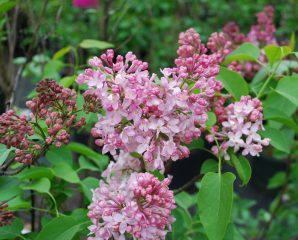Lilacs are an ever-popular spring bloomer that always seems to excite the homeowner. The large clusters of purple flowers with their well-known fragrance have made them a must-have for many years. Most New Englanders are familiar with the Common Lilac (S. vulgaris), but please consider the Preston Lilac Hybrids (cross between S. villosa and S. komarowii subsp. reflexa) such as ‘Donald Wyman’ or ‘James MacFarlane’ (seen here) for a change. Here’s why:
Flowers – Deep pink/reddish in bud and flower; the large clusters measure 6×4″ for ‘Donald Wyman’ and ‘James MacFarlane’ which is similar but with the clear pink flowers seen here; they are not quite as fragrant as Common Lilac, but still scented.
Bloom time – Later than Common Lilac, usually late May for us
Foliage – Coarser than Common Lilac, ‘Donald Wyman being less so and a darker green; they are more resistant to powdery mildew
Habit – Non-suckering which is nice, upright and dense, staying fuller at the base than Common Lilac
Size – Averaging 8-10′ tall
Hardiness – Zones 3-7
Plant them in soil that is well drained with a pH of near neutral and in full sun for the best flowering. Trim back right after flowering to keep the plant neat looking and to assure good flowering for next year.
It’s a nice choice for a single specimen, and great for hedging or in a larger mixed border. Their upright habit lends itself very well to underplanting. Spring flowering bulbs of any type look great but consider also perennials such as Cranesbill Geranium ‘Rozanne’ or ‘Biokovo’ for a splash of color at the base.
For a succession of fragrant lilac blossoms, plant a mix of them starting with Common Lilac (S. vulgaris), Meyer Lilac (S. meyeri ‘Palabin’) Manchurian Lilac (S. patula ‘Miss Kim’) and the Preston Hybrids (S. x prestoniae). Adding a Japanese Tree Lilac would extend it even further giving you flowering Lilacs from May through late June!
Remember to put them on your list for this spring!

